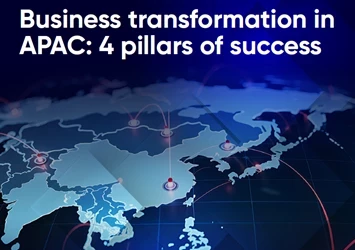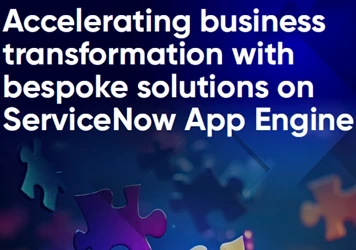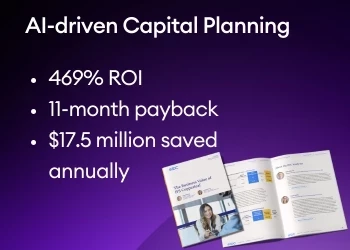There is a revolution currently taking place in business, writes columnist Dan Morris. What does this mean for you and the future of business transformation?
Business Architects working with Business Process Architects and Enterprise Architects have an unprecedented opportunity to actually transform companies and deliver a bold vision of possible operations in the future. Technology exists to change the very way business is thought of today. Working in collaboration, we can jointly present new options to help senior management create a bold vision and proactively move to build a new business model that will position the company to win in the changing society that defines today and tomorrow. This is the real future of BPM and Business Transformation – this is where value is really maximized.
Dare to be Creative and Innovative
No one has a corner on the good idea market. Good ideas are everywhere. Creativity is not as widespread, but it too, is everywhere. Knowledge and skills, and dedicated, hardworking people and managers are also everywhere. Over the past 20 years, companies have in many ways stifled big thinking and they have driven fear into their operations. The constant downsizing and punishment for new idea failures has been devastating. I see it everywhere – in companies of all sizes. I hear about great ideas that people are afraid to bring forward. I see it in the unending need to get buy-in for simple decisions. These things are really constraints and they are not helpful. They suck the energy out of organizations and people. But being part of the BPM revolution has taught me that these things really don’t need to exist. All we need is the courage to challenge the status quo – and yes, that is scary.
But it is also what will give us the freedom to consider big ideas for the future. Ideas that will shape our companies and determine who will win and who will slowly die a lingering death from a financial downward spiral.
First, I urge everyone to consider that fear of change in business today is a choice. The best among us will understand that bold action is needed and have the background and skills to properly define the changes and prove that they should be considered by senior management. That adds salesmanship to the list of skills business transformation professionals need, but it is doable.
Secondly, I believe that everyone who is at or aspires to rise to the Business Architect or Process Architect levels work to gain a solid understanding of technology. This includes BPMS, applications design and construction, data modeling and data flow, social mobility computing, and more. This will set them apart and allow them to creatively look at how they can repurpose the company’s technology investment.
Thirdly, I suggest that everyone learn all they can about emerging technology and creatively look at different markets and the way customers are changing the way they interact with companies. As the technology driven social digital revolution that is changing societies around the world (regardless of a country’s culture or economic conditions) continues, it will be critical to understand company/customer interaction and move proactively to remove barriers that limit that interaction.
Together, these changes will set the foundation for informed, knowledge based creative thinking. If the big idea is good and can be proven, it can be sold to senior management – but you do need to figure out how to form the relationships that will give your ideas an open, unbiased hearing. That is where reading a company’s culture and an ability to go around or remove impediments comes in. Still not easy, but architects don’t deal with easy.
The Burden of the Past 15 Years
Unfortunately, the last 15 years has stifled a lot of innovation while promoting it. As Deming alludes to, slogans and words are cheap. We have been living through a time when there is little relationship between words and action on the part of many. As a result of this reality and the constant attack on cost, fear has become a guiding beacon in many companies and people are so afraid of failing that little gets done without 243 people agreeing to it! That means little really changes – corporate life goes on with only small tweaks to what they are already doing.
If that is the real appetite for change, OK. But there could be so much more.
For all of us, the way things were is often romanticized to turn bad memories into good ones. The way things are today was once scary, but it now comfortable – the workaround activities are in place and even if life is not good, it is often comfortable. That is small thinking and it is based on the “reality” that is defined by fear of change.
But let me tell everyone as a longtime observer of corporate operations, the old times were not as good as you would like to remember and current times have a lot of problems, if you are honest about it. That leaves the future. And there, things can be great. The future is all about potential and it is about bold change and big ideas. It is also about your dreams for how things could be and about making those visions reality.
Moving Forward
This is not about looking backward. It is also not about some pie in the sky concept that is great to propose, but is dead on arrival at most companies. This is about you and what you can accomplish if you are bold enough to think big and work for better. We have the hard-won knowledge to really make a difference and the underlying technology to build any dream we can have – short of seeing what is on the other side of the black hole event horizon we hear about on the Science Channel on TV.
We had good years in the 1980s and the 1990s weren’t too bad – even with the Y2K scare. The early 2000s were not as good with the start of business downturns and the past 8 years of business have been somewhat of a self-induced disaster. But during the last 15 years the BPMS vendors have really created magic. BPM professionals have also learned and evolved and many are now experienced practitioners.
We have also lived through the “there is too much fat in the company” craze – although we are still dealing with the results of cutting cost to the bone and the destruction of company loyalty it brings. We have the foundation to build a new type of company and a new type of business world. Everything we need is available and there continues to be tremendous new opportunities driven by technology such as iBPM, cloud computing, low code platforms, the internet of all things, and more. We now simply need to learn and to leverage that knowledge boldly to really transform businesses and create the nimbleness in operational change to deliver a competitive advantage.
This is not a world that will be comfortable for small improvement thinkers. It is a world of bold change that reflects the techno-society that the world has evolved into over the past 15 or 20 years.
But are our companies ready to go through a business evolution mirroring the social and technical revolutions that have been going on in our daily lives? Some are and some aren’t. Where we can, we need to start to leverage our knowledge and technical capabilities to think in broader and bolder terms. We also need to start moving our focus from cost reduction to revenue increase and we need to start to build the internal mind set and operational capability that will allow us to truly help one another succeed.
Our challenge is how to help improve the way our companies relate to customers, sell to customers, and deal with their issues. These are the things that differentiate. It is not our accounting systems or HR systems or other core systems – which we must have and which must function efficiently. But even the best of these systems will not help differentiate a company. No one gets bragging rights for a good Accounts Receivable application.
Bragging rights in the future will be limited to those processes and supporting technology that provide competitive advantage and deliver services and products. Bragging rights will be moved from cost reduction to revenue growth as companies start to focus on expansion and cutting into one another’s share of the proverbial market pie.
This has started in many companies and it is being driven by new concepts that are invigorating the business transformation industry. The trend is starting . These more progressive and visionary companies are led and managed by bold thinking individuals. They are not interested in the status quo or in making small changes with small improvements to the bottom line. These people are investors in the future. They are redefining the game and the playing field. They are looking at growth differently as they prepare their companies to be dominant players in the future.
This is exciting stuff for BPM professionals.
The fact is that we are entering one of the greatest times in history. Technology is changing everything. As it does, people are evolving and they are causing society to evolve. Even remote corners of the globe are now not so remote with satellite phones and communications. Even where there is no real public power grid, there is the potential for solar cell power and the potential for the use of wind turbines to deliver the power needed at the individual level to support access to an unparalleled amount of information. This is in turn opening untapped markets and presenting new opportunities.
So the question becomes “what will we do with this potential?” If we can envision most things, we can start to make them reality. It will take work and it will take vision, but we have the ability and the capacity to build what we can envision. Yes, we will have to sell it to everyone and we will have to drag some nay-sayers kicking and screaming into the future. That is the way things will always be.
I am amazed at what I see in many companies and the way technology is changing the world – and creating a new comfortable reality for young people. It is also interesting to see that even older people are embracing the new technologies and buying into the evolution that is causing the way we look at our lives and the way we interact with one another and companies to change.
Of course there are dangers. Of course there are managers who will fight anything new. Of course, there are those who will look at every improvement as an excuse to reduce staff or control workers and threaten them. All of it will be true in some places. I just hope not too many.
Real Growth
A lack of real growth has been a problem in the last 15 years. The passage of time, however, is changing business focus and the time for big ideas that are creative and leverage innovation in BPMS and other technologies is now emerging. This is what will expand a company’s foot print and grow revenue.
In the past 15 years the question has been “how can we cut costs?” Some have been more successful than others and some have caused long term harm as investments in the company have been indefinitely delayed. The short term result has been increased margins – more profit per sale. And, while that is regarded as a good thing, the focus should now shift. The changes that have taken place in the past 15 years have reached a point where the whole business game has changed. Not only is the business game played in the physical world of stores, it is also played in electronic stores and in cyber space. Some would say the world has changed – and it has. I firmly believe we are only at the front end of the change. I also believe that the upcoming changes will open as many new opportunities as the past presented – they will just be different. But will you and the company you work for have the foresight to look into what is emerging and then form the big ideas needed to leverage it to win?
I believe that the strategic question will soon shift to “how can we grow revenue – how can we expand?” I am seeing more companies begin to make this move. I also believe that timid goals and uninspired vision, will not position any company to do more than survive for a while.
The winners in this game of business evolution will be those who are bold enough to leverage new technology and envision ways to adjust to changes in the way people interact with companies. But, this vision will have little effect unless these managers also have the will to enable the work needed to create change and transform the company. The biggest winners however, will be those who recognize the value of people, skills, knowledge, and corporate history. Why? Because knowing the business and why the current operation is the way it is has value. In the mid-1990s Michael Hamer said that companies should literally blow up their operations and start over. That didn’t work and caused many companies a great deal of problems. One of the biggest reasons is that any company has history and things are done for a reason. The reasons may be poor, the logic may be faulty, and execution may be inefficient, but there is value in history and if it is forgotten it will repeat itself.
So I suggest that while you may want to totally start over and come up with a design that delivers a new conceptual vision for the future, you need to start with where you are, recognize and evaluate company history, and then decide how to move from where you are to the new vision-based model. This will help you understand if any current policy, rule, or procedure really has value and should be considered in the future model. It will also acquaint you with constraints and compliance needs. The good thing about this analysis and evaluation, if you do it right, is that this forces you to look at everything and decide what needs to be carried forward in some form and what can be abandoned. That tells you the good, the bad, and the ugly about the company’s operation. Understanding this baseline, you will now be free to innovate in a positive way and to plan for the evolution of the company in steps that are tied to the ability of the company to fund and deliver change.
Foundation
A problem of the past 15 years is that many people have been so intent on fixing immediate problems that they have become focused on a small part of the overall operation and have lost sight of the big picture. While this focus was needed to reduce costs and improve operations, it has caused many companies to fall behind in their operational evolution – limiting their ability to creatively embrace new technology and adjust to emerging differences in buying patterns and customer interaction.
I believe that recognition of this fact is driving the voice of the customer/ customer journey / customer experience movement. But while these movements are addressing the right concepts, companies need the business and IT infrastructure, and the operational capabilities to do more than issue slogans and put up posters. This is where big thinking and big vision come into play. It is a need to look holistically at the vision and then at the changes needed to deliver it. But as important as this big thinking is to the future of companies and business, is the ability to do something about it. A vision without the ability to act on it is just frustrating. This is where a commitment to the future comes into play.
Companies should adopt a strategy for transforming the company that is focused on innovation and flexibility. This requires that they create an investment plan for IT to modernize its infrastructure, tools and application development capability and to allow it to stay focused on evaluating emerging technology. This will help create an ability to move quickly with low cost and low risk. This is really where the strategy of moving to a digital enterprise comes in. And yes, this will require a very different technology architecture than we have had in the past.
IT is not the only place we need to build different capabilities. Business change today is an interesting mix of companies with fairly mature change capabilities and companies that are really just starting into formal BPM based change. Because business must drive this movement to evolve, companies need to build formal transformation capabilities. These business evolution groups should also be separate but closely linked to IT – each has an important role to play, but these roles are very different.
Courage to Think Out of the Box
Business transformation is based on Business Reengineering. It is meant to encourage people to think boldly and critically look at the operation and its flaws. This requires the courage to question everything and to potentially step on toes. It also implies the need to leverage business and technology knowledge creatively to propose big ideas on how the company could evolve and what that path would mean.
We must recognize that there will be impediments and constraints. This is just reality. I believe that any obstacle can be overcome. We do need to start out by identifying what will stand in the way of any big thinking vision. We need to be honest and realistic. Then we need to apply our creativity. This will separate people. For this part of the journey to evolve, we need people who can solve the tough problems. We need people who encourage others to adopt a philosophy of “Don’t just talk about the problems, anyone can do that. Tell me how to solve them or get around them”.
We need people who want to build and get excited about a role in helping a company prepare to thrive in a future society that is emerging right now. These are the skills that must be developed today if we are going to succeed in the future.
Each of us can make a difference in how our companies operate and how they prepare for success in the future. We just need to do it the right way. That way is to build a case for the ideas based on an understanding of what drives the company and what its big problems are, and then creatively look at how business transformation and available or emerging technology can solve them. It then becomes a matter of justifying your ideas, building a compelling case, and selling them to anyone who will listen. That is honestly not easy and it is not something that will happen in most companies overnight.
However, radical business change is coming and it is coming fast as it rides the back of the technology monster. The question is: what role do you want to play in the world that is coming? Whatever your decision, it will clearly be up to us all to rock the cost reduction boat by proposing revenue expanding ideas in a larger vision of a true rethinking of business operations.
As always, my goal is to make my readers think. Status quo is easy. It is also fairly easy to chip away at the current state and improve it instead of transforming it. Both have their places in a business, and both deliver significant value. But in the future, I propose that the real value is in bold thinking and creatively reinventing the operations. Of course, there will be those who disagree.
I welcome all thoughts – even disagreements. We learn from all perspectives if we are open to questioning everything we know.
The fact is that innovative people learn, challenge, creatively propose innovation, and test it. Then we start over by keeping up with new ideas and challenging them as we learn more. These are the people who change our companies and make a real difference. Being bold and thinking big is a choice. Having the ability to take these ideas and justify them, sell them to others, and tenaciously keep trying until you have proven the value of the change requires different skills and innovation. It also requires courage because this is where risk lives.
We have the technology, the techniques, the methodology and experience. Now we simply need to envision the future and determine what it will take to sell it and built it.
[inlinead]





















